Assessing Non-Point Source Pollution in a Rapidly Urbanizing Sub-Basin to Support Intervention Planning
Abstract
1. Introduction
2. Study Area
3. Data and Methods
3.1. SWAT Model
3.2. Model Setup
3.3. Data Collection and Processing
3.4. LULC Mapping and LULC Change Analysis
3.5. Calibration, Parameterisation, and Uncertainty Analysis
3.5.1. Sensitivity Analysis
3.5.2. Calibration and Validation
3.6. The SWAT Model Performance Assessment
4. Results and Discussion
4.1. Changes in the Land Use and Land Cover
4.2. Hydrological Model Output
4.2.1. Analysing Sensitivity
4.2.2. Calibration and Validation of Streamflow
4.2.3. Calibration and Validation of the Sediment Load
4.2.4. Soil Erosion Rate Spatial Distribution
4.2.5. Nutrient Load Calibration and Validation
4.2.6. Variations in Surface Runoff, Sediment, and Nutrient Load in Space and Time
- A.
- Soil and nutrient load spatial variations
- B.
- Temporal variations of nutrient and soil load
4.2.7. The Effects of LULC Changes on Sediment, Runoff, and Nutrient Load
- A.
- Surface Runoff
- B.
- Sediment load
- C.
- Nitrate and Phosphate Load
- D.
- Load of total nitrogen and total phosphorous
5. Conclusions
Supplementary Materials
Author Contributions
Funding
Data Availability Statement
Acknowledgments
Conflicts of Interest
References
- Pulighe, G.; Bonati, G.; Colangeli, M.; Traverso, L.; Lupia, F.; Altobelli, F.; Marta, A.D.; Napoli, M. Predicting streamflow and nutrient loadings in a semi-arid Mediterranean watershed with ephemeral streams using the SWAT model. Agronomy 2020, 10, 2. [Google Scholar] [CrossRef]
- Sharifinia, M.; Adeli, B.; Nafarzadegan, A.R. Evaluation of water quality trends in the Maroon River Basin, Iran, from 1990 to 2010 by WQI and multivariate analyses. Environ. Earth Sci. 2017, 76, 781. [Google Scholar] [CrossRef]
- Sharifinia, M.; Zohreh, R.; Javid, I.; Abbas, M.; Tahsin, R. Water quality assessment of the Zarivar Lake using physico-chemical parameters and NSF- WQI indicator, Kurdistan Province-Iran. Int. J. Adv. Biol. Biomed. Res. 2013, 1, 302–312. [Google Scholar]
- Vagstad, N.; Stålnacke, P.; Andersen, H.E.; Deelstra, J.; Jansons, V.; Kyllmar, K.; Loigu, E.; Rekolainen, S.; Tumas, R. Regional variations in diffuse nitrogen losses from agriculture in the Nordic and Baltic regions. Hydrol. Earth Syst. Sci. 2004, 8, 651–662. [Google Scholar] [CrossRef][Green Version]
- Liu, Y.; Li, H.; Cui, G.; Cao, Y. Water quality attribution and simulation of non-point source pollution load flux in the Hulan River basin. Sci. Rep. 2020, 10, 3012. [Google Scholar] [CrossRef]
- Sorando, R.; Comín, F.A.; Jiménez, J.J.; Sánchez-Pérez, J.M.; Sauvage, S. Water resources and nitrate discharges in relation to agricultural land uses in an intensively irrigated watershed. Sci. Total Environ. 2019, 659, 1293–1306. [Google Scholar] [CrossRef]
- Li, J.; Li, H.; Shen, B.; Li, Y. Effect of non-point source pollution on water quality of the Weihe River. Int. J. Sediment Res. 2011, 26, 50–61. [Google Scholar] [CrossRef]
- Hou, L.; Zhou, Z.; Wang, R.; Li, J.; Dong, F.; Liu, J. Research on the Non-Point Source Pollution Characteristics of Important Drinking Water Sources. Water 2022, 14, 211. [Google Scholar] [CrossRef]
- Han, L.X.; Huo, F.; Sun, J. Method for calculating non-point source pollution distribution in plain rivers. Water Sci. Eng. 2011, 4, 83–91. [Google Scholar] [CrossRef]
- Assegide; Alamirew, T.; Dile, Y.T.; Bayabil, H.; Tessema, B.; Zeleke, G. A Synthesis of Surface Water Quality in Awash Basin, Ethiopia. Front. Water 2022, 4, 782124. [Google Scholar] [CrossRef]
- Assegide; Alamirew; Bayabil, H.; Dile, Y.T.; Tessema, B.; Zeleke, G. Impacts of Surface Water Quality in the Awash River Basin, Ethiopia: A Systematic Review. Front. Water 2022, 3, 790900. [Google Scholar] [CrossRef]
- Ligdi, E.E.; El Kahloun, M.; Meire, P. Ecohydrological status of Lake Tana—A shallow highland lake in the Blue Nile (Abbay) basin in Ethiopia: Review. Ecohydrol. Hydrobiol. 2010, 10, 109–122. [Google Scholar] [CrossRef]
- Legesse, E.E.; Srivastava, A.K.; Kuhn, A.; Gaiser, T. Household welfare implications of better fertilizer access and lower use inefficiency: Long-term scenarios for Ethiopia. Sustainability 2019, 11, 3952. [Google Scholar] [CrossRef]
- Ongley, E.D.; Xiaolan, Z.; Tao, Y. Current status of agricultural and rural non-point source Pollution assessment in China. Environ. Pollut. 2010, 158, 1159–1168. [Google Scholar] [CrossRef]
- Wang, A.; Tang, L.; Yang, D. Spatial and temporal variability of nitrogen load from catchment and retention along a river network: A case study in the upper Xin’anjiang catchment of China. Hydrol. Res. 2016, 47, 869–887. [Google Scholar] [CrossRef]
- Sebilo, M.; Mayer, B.; Nicolardot, B.; Pinay, G.; Mariotti, A. Long-term fate of nitrate fertilizer in agricultural soils. Proc. Natl. Acad. Sci. USA 2013, 110, 18185–18189. [Google Scholar] [CrossRef]
- Jenkinson, D.S.; Parry, L.C. The nitrogen cycle in the broadbalk wheat experiment: A model for the turnover of nitrogen through the soil microbial biomass. Soil Biol. Biochem. 1989, 21, 535–541. [Google Scholar] [CrossRef]
- Belete, F.; Dechassa, N.; Molla, A.; Tana, T. Effect of nitrogen fertilizer rates on grain yield and nitrogen uptake and use efficiency of bread wheat (Triticum aestivum L.) varieties on the Vertisols of central highlands of Ethiopia. Agric. Food Secur. 2018, 7, 78. [Google Scholar] [CrossRef]
- Giordano, M.; Petropoulos, S.A.; Rouphael, Y. The fate of nitrogen from soil to plants: Influence of agricultural practices in modern agriculture. Agriculture 2021, 11, 944. [Google Scholar] [CrossRef]
- Neitsch, S.; Arnold, J.; Kiniry, J.; Williams, J. Soil & Water Assessment Tool Theoretical Documentation Version 2009; Texas Water Resources Institute: College Station, TX, USA, 2011; pp. 1–647. [Google Scholar] [CrossRef]
- Adimassu, Z.; Langan, S.; Johnston, R.; Mekuria, W.; Amede, T. Impacts of Soil and Water Conservation Practices on Crop Yield, Run-off, Soil Loss and Nutrient Loss in Ethiopia: Review and Synthesis. Environ. Manag. 2017, 59, 87–101. [Google Scholar] [CrossRef]
- Hurni, K.; Zeleke, G.; Kassie, M.; Tegegne, B.; Kassawmar, T.; Teferi, E.; Moges, A.; Tadesse, D.; Ahmed, M.; Degu, Y.; et al. The Economics of Land Degradation. Ethiopia Case Study. Soil Degradation and Sustainable Land Management in the Rainfed Agricultural Areas of Ethiopia: An Assessment of the Economic Implications; Water and Land Resource Centre (WLRC): Bonn, Deutschland; Centre for Development and Environment (CDE): Bonn, Deutschland; Deutsche Gesellschaft für Internationale Zusammenarbeit (GIZ): Bonn, Deutschland, 2015. [Google Scholar]
- Tamene, L.; Abera, W.; Demissie, B.; Desta, G.; Woldearegay, K.; Mekonnen, K. Soil erosion assessment in Ethiopia: A review. J. Soil Water Conserv. 2022, 77, 144–157. [Google Scholar] [CrossRef]
- Bihonegn, B.G.; Awoke, A.G. Evaluating the impact of land use and land cover changes on sediment yield dynamics in the upper Awash basin, Ethiopia the case of Koka reservoir. Heliyon 2023, 9, e23049. [Google Scholar] [CrossRef] [PubMed]
- Jilo, N.B.; Gurara, M.A.; Tolche, A.D.; Harka, A.E. Impacts of Management Scenarios on Sediment Yield Simulation in Upper and Middle Awash River Basin, Ethiopia. Ecohydrol. Hydrobiol. 2022, 22, 269–282. [Google Scholar] [CrossRef]
- Rothman, N.; Rothstein, D.; Foor, F.; Magasanik, B. Water Quality Assessments—A Guide to Use of Biota, Sediments and Water in Environmental Monitoring—Second Edition. J. Bacteriol. 1982, 150, 221–230. [Google Scholar] [CrossRef]
- Tolera, M.B.; Chung, I.M.; Chang, S.W. Evaluation of the climate forecast system reanalysis weather data for watershed modeling in Upper Awash Basin, ethiopia. Water 2018, 10, 725. [Google Scholar] [CrossRef]
- Chan, W.C.H.; Thompson, J.R.; Taylor, R.G.; Nay, A.E.; Ayenew, T.; MacDonald, A.M.; Todd, M.C. Uncertainty assessment in river flow projections for Ethiopia’s Upper Awash Basin using multiple GCMs and hydrological models. Hydrol. Sci. J. 2020, 65, 1720–1737. [Google Scholar] [CrossRef]
- Arnold, J.G.; Srinivasan, R.; Muttiah, R.S.; Williams, J.R. Large area Hydrologic Modeling and Assessment Part I: Model development. Am. Water Resour. Assoc. 1998, 34, 73–89. [Google Scholar] [CrossRef]
- Mohammad, M.E.; Al-Ansari, N.; Knutsson, S. Application of SWAT model to estimate the annual runoff and sediment of Duhok reservoir watershed. In Proceedings of the 8th International Conference on Scour and Erosion, Oxford, UK, 12–15 September 2016; pp. 1129–1136. [Google Scholar] [CrossRef]
- Uribe, N.; Corzo, G.; Quintero, M.; van Griensven, A.; Solomatine, D. Impact of conservation tillage on nitrogen and phosphorus runoff losses in a potato crop system in Fuquene watershed, Colombia. Agric. Water Manag. 2018, 209, 62–72. [Google Scholar] [CrossRef]
- Tessema, S.M.; Setegn, S.G.; Mörtberg, U. Watershed modeling as a tool for sustainable water resources management: SWAT model application in the awash river basin, Ethiopia. In Sustainability of Integrated Water Resources Management: Water Governance, Climate and Ecohydrology; Springer International Publishing: Berlin/Heidelberg, Germany, 2015; pp. 579–606. [Google Scholar] [CrossRef]
- Alves, G.J.; Rogério de Mello, C.; Beskow, S.; Junqueira, J.A.; Nearing, M.A. Assessment of the soil conservation service–curve number method performance in a tropical oxisol watershed. J. Soil Water Conserv. 2019, 74, 500–512. [Google Scholar] [CrossRef]
- Green, W.H.; Ampt, G. Studies on soil physics (Part I): The flow of Air and Water Through Soil. J. Agric. Sci. 2011, 4, 1–24. [Google Scholar]
- Hargreaves, G.H.; Samani, Z.A. Reference Crop Evapotranspiration From Ambient Air Temperature. Pap.-Am. Soc. Agric. Eng. 1985, 1, 96–99. [Google Scholar] [CrossRef]
- Attanasi, E.D.; Johnson, S.R.; Leduc, S.; Mcquigg, J.D. Forecasting Work Conditions for Road Construction Activities: An Application of Alternative Probability Models. Mon. Weather Rev. 1973, 101, 223–230. [Google Scholar] [CrossRef]
- Williams, J.R. Flood Routing with Variable Travel Time or Variable Storage Coefficients. Trans. ASAE 1969, 12, 0100–0103. [Google Scholar] [CrossRef]
- Winchell, M.F.; Peranginangin, N.; Srinivasan, R.; Chen, W. Soil and Water Assessment Tool model predictions of annual maximum pesticide concentrations in high vulnerability watersheds. Integr. Environ. Assess. Manag. 2018, 14, 358–368. [Google Scholar] [CrossRef]
- Ouyang, Y. A Gap-Filling Tool: Predicting Daily Sediment Loads Based on Sparse Measurements. Hydrology 2022, 9, 181. [Google Scholar] [CrossRef]
- Kaleab, H.; Mamo, M.; Jain, M. Runoff and Sediment Modeling Using SWAT in Gumera Catchment, Ethiopia. Open J. Mod. Hydrol. 2013, 3, 196–205. [Google Scholar] [CrossRef]
- Wang, G.; Jager, H.I.; Baskaran, L.M.; Baker, T.F.; Brandt, C.C. SWAT Modeling of Water Quantity and Quality in the Tennessee River Basin: Spatiotemporal Calibration and Validation. Hydrol. Earth Syst. Sci. Discuss. 2016, 2016, 1–33. [Google Scholar] [CrossRef]
- Noori, N.; Kalin, L.; Isik, S. Water quality prediction using SWAT-ANN coupled approach. J. Hydrol. 2020, 590, 125220. [Google Scholar] [CrossRef]
- Kim, J.; Lim, K.J.; Park, Y.S. Evaluation of Regression Models of LOADEST and Eight-Parameter Model for Nitrogen Load Estimations. Water Air Soil Pollut. 2018, 229, 179. [Google Scholar] [CrossRef]
- Han, Y.; Liu, Z.; Chen, Y.; Li, Y.; Liu, H.; Song, L.; Chen, Y. Assessing non-point source pollution in an apple-dominant basin and associated best fertilizer management based on SWAT modeling. Int. Soil Water Conserv. Res. 2023, 11, 353–364. [Google Scholar] [CrossRef]
- Lee, S.; Yeo, I.Y.; Sadeghi, A.M.; McCarty, G.W.; Hively, W.D.; Lang, M.W.; Sharifi, A. Comparative analyses of hydrological responses of two adjacent watersheds to climate variability and change using the SWAT model. Hydrol. Earth Syst. Sci. 2018, 22, 689–708. [Google Scholar] [CrossRef]
- Abbaspour, K.C.; Yang, J.; Maximov, I.; Siber, R.; Bogner, K.; Mieleitner, J.; Zobrist, J.; Srinivasan, R. Modelling hydrology and water quality in the pre-alpine/alpine Thur watershed using SWAT. J. Hydrol. 2007, 333, 413–430. [Google Scholar] [CrossRef]
- Thavhana, M.P.; Savage, M.J.; Moeletsi, M.E. SWAT model uncertainty analysis, calibration and validation for runoff simulation in the Luvuvhu River catchment, South Africa. Phys. Chem. Earth 2018, 105, 115–124. [Google Scholar] [CrossRef]
- Narsimlu, B.; Gosain, A.K.; Chahar, B.R.; Singh, S.K.; Srivastava, P.K. SWAT Model Calibration and Uncertainty Analysis for Streamflow Prediction in the Kunwari River Basin, India, Using Sequential Uncertainty Fitting. Environ. Process. 2015, 2, 79–95. [Google Scholar] [CrossRef]
- Gholami, A.; Habibnejad Roshan, M.; Shahedi, K.; Vafakhah, M.; Solaymani, K. Hydrological stream flow modeling in the Talar catchment (central section of the Alborz Mountains, north of Iran): Parameterization and uncertainty analysis using SWAT-CUP. J. Water Land Dev. 2016, 30, 57–69. [Google Scholar] [CrossRef]
- Emiru, N.C.; Recha, J.W.; Thompson, J.R.; Belay, A.; Aynekulu, E.; Manyevere, A.; Demissie, T.D.; Osano, P.M.; Hussein, J.; Molla, M.B.; et al. Impact of Climate Change on the Hydrology of the Upper Awash River Basin, Ethiopia. Hydrology 2022, 9, 3. [Google Scholar] [CrossRef]
- Arnold, J.G.; Moriasi, D.N.; Gassman, P.W.; Abbaspour, K.C.; White, M.J.; Srinivasan, R.; Santhi, C.; Harmel, R.D.; van Griensven, A.; Van Liew, M.W.; et al. SWAT: Model use, calibration, and validation. Trans. ASABE 2012, 55, 1491–1508. [Google Scholar] [CrossRef]
- Maroneze, M.M.; Zepka, L.Q.; Vieira, J.G.; Queiroz, M.I.; Jacob-Lopes, E. Sensitivity analysis of the Soil and Water Assessment Tools (SWAT) model in streamflow modeling in a rural river basin. Rev. Ambiente Agua 2014, 9, 445–458. [Google Scholar] [CrossRef]
- Cui, X.; Sun, W.; Teng, J.; Song, H.; Yao, X. Effect of length of the observed dataset on the calibration of a distributed hydrological model. IAHS-AISH Proc. Rep. 2015, 368, 305–311. [Google Scholar] [CrossRef][Green Version]
- Misaghi, F.; Nasrabadi, M.; Nouri, M. Application of swat model to simulate nitrate and phosphate leaching from agricultural lands to the rivers. Adv. Environ. Technol. 2020, 6, 1–17. [Google Scholar] [CrossRef]
- Abbaspour, K.C. SWAT-CUP: SWAT Calibration and Uncertainty Programs—A User Manual; Swiss Federal Institute of Aquatic Science and Technology: Eawag, Switzerland, 2015. [Google Scholar]
- Abbaspour, K.C. A Package of Calibration Procedures Linked to SWAT Through a Generic Platform to Perform Calibration, Validation, and Uncertainty Analysis SWAT-CUP. 2012. Available online: https://envirogrids.net/envirogrids_d4.5_calibration_swat_cupdfb0.pdf?option=com_jdownloads&Itemid=13&view=finish&cid=145&catid=13 (accessed on 27 March 2023).
- Takele, L.; Kebede, M. Streamflow Modeling of Upper Awash River Basin Using Soil and Water Assessment Tool. Appl. J. Environ. Eng. Sci. 2018, 4, 456–466. [Google Scholar]
- Moriasi, D.N.; Arnold, J.G.; Van Liew, M.W.; Bingner, R.L.; Harmel, R.D.; Veith, T.L. Model Evaluation Guidelines for Systematic Quantification of Accuracy in Watershed Simulations. Trans. ASABE 2007, 50, 885–900. [Google Scholar] [CrossRef]
- Veltman, K.; Rotz, C.A.; Chase, L.; Cooper, J.; Ingraham, P.; Izaurralde, R.C.; Jones, C.D.; Gaillard, R.; Larson, R.A.; Ruark, M.; et al. A quantitative assessment of Beneficial Management Practices to reduce carbon and reactive nitrogen footprints and phosphorus losses on dairy farms in the US Great Lakes region. Agric. Syst. 2018, 166, 10–25. [Google Scholar] [CrossRef]
- Cooper, M. Multi-variable and multi-site calibration and validation of SWAT in a large mountainous catchment with high spatial variability. Hydrol. Process. 2007, 2274, 2267–2274. [Google Scholar]
- Im, S.; Brannan, K.M.; Mostaghimi, S.; Kim, S.M. Comparison of HSPF and SWAT models performance for runoff and sediment yield prediction. J. Environ. Sci. Health—Part A Toxic/Hazardous Subst. Environ. Eng. 2007, 42, 1561–1570. [Google Scholar] [CrossRef]
- Coffey, M.E.; Workman, S.R.; Taraba, J.L.; Fogle, A.W. Statistical Procedures for Evaluating Daily and Monthly Hydrologic Model Predictions. Trans. ASABE 2004, 47, 59–68. [Google Scholar] [CrossRef]
- Legates, G. Evaluating the use of “goodness-of-fit” measures in hydrologic and hydroclimatic model validation. Water Resour. Res. 2007, 35, 233–241. [Google Scholar] [CrossRef]
- Mendez, M.; Calvo-Valverde, L.A.; Imbach, P.; Maathuis, B.; Hein-Grigg, D.; Hidalgo-Madriz, J.A.; Alvarado-Gamboa, L.F. Hydrological Response of Tropical Catchments to Climate Change as Modeled by the GR2M Model: A Case Study in Costa Rica. Sustainability 2022, 14, 16938. [Google Scholar] [CrossRef]
- Golmohammadi, G.; Prasher, S.; Madani, A.; Rudra, R. Evaluating Three Hydrological Distributed Watershed Models: MIKE-SHE, APEX, SWAT. Hydrology 2014, 1, 20–39. [Google Scholar] [CrossRef]
- Almeida, R.A.; Pereira, S.B.; Pinto, D.B.F. Calibration and validation of the SWAT hydrological model for the Mucuri river basin. Eng. Agric. 2018, 38, 55–63. [Google Scholar] [CrossRef]
- Tang, F.F.; Xu, H.S.; Xu, Z.X. Model calibration and uncertainty analysis for runoff in the Chao River Basin using sequential uncertainty fitting. Procedia Environ. Sci. 2012, 13, 1760–1770. [Google Scholar] [CrossRef]
- El-Sadek, A.; Irvem, A. Evaluating the impact of land use uncertainty on the simulated streamflow and sediment yield of the Seyhan River basin using the SWAT model. Turk. J. Agric. For. 2014, 38, 515–530. [Google Scholar] [CrossRef]
- Mapes, K.L.; Pricope, N.G. Evaluating SWAT model performance for runoff, percolation, and sediment loss estimation in low-gradientwatersheds of the Atlantic Coastal Plain. Hydrology 2020, 7, 21. [Google Scholar] [CrossRef]
- Kefay, T.; Abdisa, T.; Tumsa, B.C. Prioritization of Susceptible Watershed to Sediment Yield and Evaluation of Best Management Practice: A Case Study of Awata River, Southern Ethiopia. Appl. Environ. Soil Sci. 2022, 2022, 945. [Google Scholar] [CrossRef]
- Gonfa, Z.B.; Kumar, D. Application of Soil and Water Assessment Tool Model to Estimate Runoff and Sediment Yield from Mojo Watershed. Int. J. Innov. Res. Sci. Eng. Technol. 2016, 5, 2081–2091. [Google Scholar] [CrossRef]
- Leta, M.K.; Ebsa, D.G.; Regasa, M.S. Parameter Uncertainty Analysis for Streamflow Simulation Using SWAT Model in Nashe Watershed, Blue Nile River Basin, Ethiopia. Appl. Environ. Soil Sci. 2022, 2022, 6942. [Google Scholar] [CrossRef]
- Abbaspour, K.C.; Rouholahnejad, E.; Vaghefi, S.; Srinivasan, R.; Yang, H.; Kløve, B. A continental-scale hydrology and water quality model for Europe: Calibration and uncertainty of a high-resolution large-scale SWAT model. J. Hydrol. 2015, 524, 733–752. [Google Scholar] [CrossRef]
- Moriasi, D.N.; Gitau, M.W.; Pai, N.; Daggupati, P. Hydrologic and water quality models: Performance measures and evaluation criteria. Trans. ASABE 2015, 58, 1763–1785. [Google Scholar] [CrossRef]
- Chekol, D.A.; Tischbein, B.; Eggers, H.; Vlek, P. Application of SWAT for assessment of spatial distribution of water resources and analyzing impact of different land management practices on soil erosion in Upper Awash River Basin watershed. FWU Water Resour. Publ. 2007, 6, 110–117. [Google Scholar]
- Jilo, N.B.; Gebremariam, B.; Harka, A.E.; Woldemariam, G.W.; Behulu, F. Evaluation of the impacts of climate change on sediment yield from the Logiya Watershed, Lower Awash Basin, Ethiopia. Hydrology 2019, 6, 81. [Google Scholar] [CrossRef]
- Chotpantarat, S.; Boonkaewwan, S. Impacts of land-use changes on watershed discharge and water quality in a large intensive agricultural area in Thailand. Hydrol. Sci. J. 2018, 63, 1386–1407. [Google Scholar] [CrossRef]
- Sattari, S.Z.; Bouwman, A.F.; Giller, K.E.; Van Ittersum, M.K. Residual soil phosphorus as the missing piece in the global phosphorus crisis puzzle. Proc. Natl. Acad. Sci. USA 2012, 109, 6348–6353. [Google Scholar] [CrossRef] [PubMed]
- Mishra, A.; Kar, S.; Singh, V.P. Prioritizing structural management by quantifying the effect of land use and land cover on watershed runoff and sediment yield. Water Resour. Manag. 2007, 21, 1899–1913. [Google Scholar] [CrossRef]
- Sajikumar, N.; Remya, R.S. Impact of land cover and land use change on runoff characteristics. J. Environ. Manag. 2015, 161, 460–468. [Google Scholar] [CrossRef] [PubMed]
- Getu Engida, T.; Nigussie, T.A.; Aneseyee, A.B.; Barnabas, J. Land Use/Land Cover Change Impact on Hydrological Process in the Upper Baro Basin, Ethiopia. Appl. Environ. Soil Sci. 2021, 2021, 6617541. [Google Scholar] [CrossRef]
- Chelkeba Tumsa, B. The Response of Sensitive LULC Changes to Runoff and Sediment Yield in a Semihumid Urban Watershed of the Upper Awash Subbasin Using the SWAT+ Model, Oromia, Ethiopia. Appl. Environ. Soil Sci. 2023, 2023, 6856144. [Google Scholar] [CrossRef]
- Santos, F.M.; de Oliveira, R.P.; Di Lollo, J.A. Effects of land use changes on streamflow and sediment yield in Atibaia River Basin-SP, Brazil. Water 2020, 12, 1711. [Google Scholar] [CrossRef]
- Kalsido, T.; Berhanu, B. Impact of Land-Use Changes on Sediment Load and Capacity Reduction of Lake Ziway, Ethiopia. Nat. Resour. 2020, 11, 530–542. [Google Scholar] [CrossRef]
- Tumsa, B.C.; Feyessa, F.F.; Tullu, K.T.; Guder, A.C. Spatiotemporal changes of land use in response to runoff and sediment yield for environmental sustainability in the upper Blue Nile Basin, Oromiyaa, Ethiopia. H2Open J. 2023, 6, 551–575. [Google Scholar] [CrossRef]
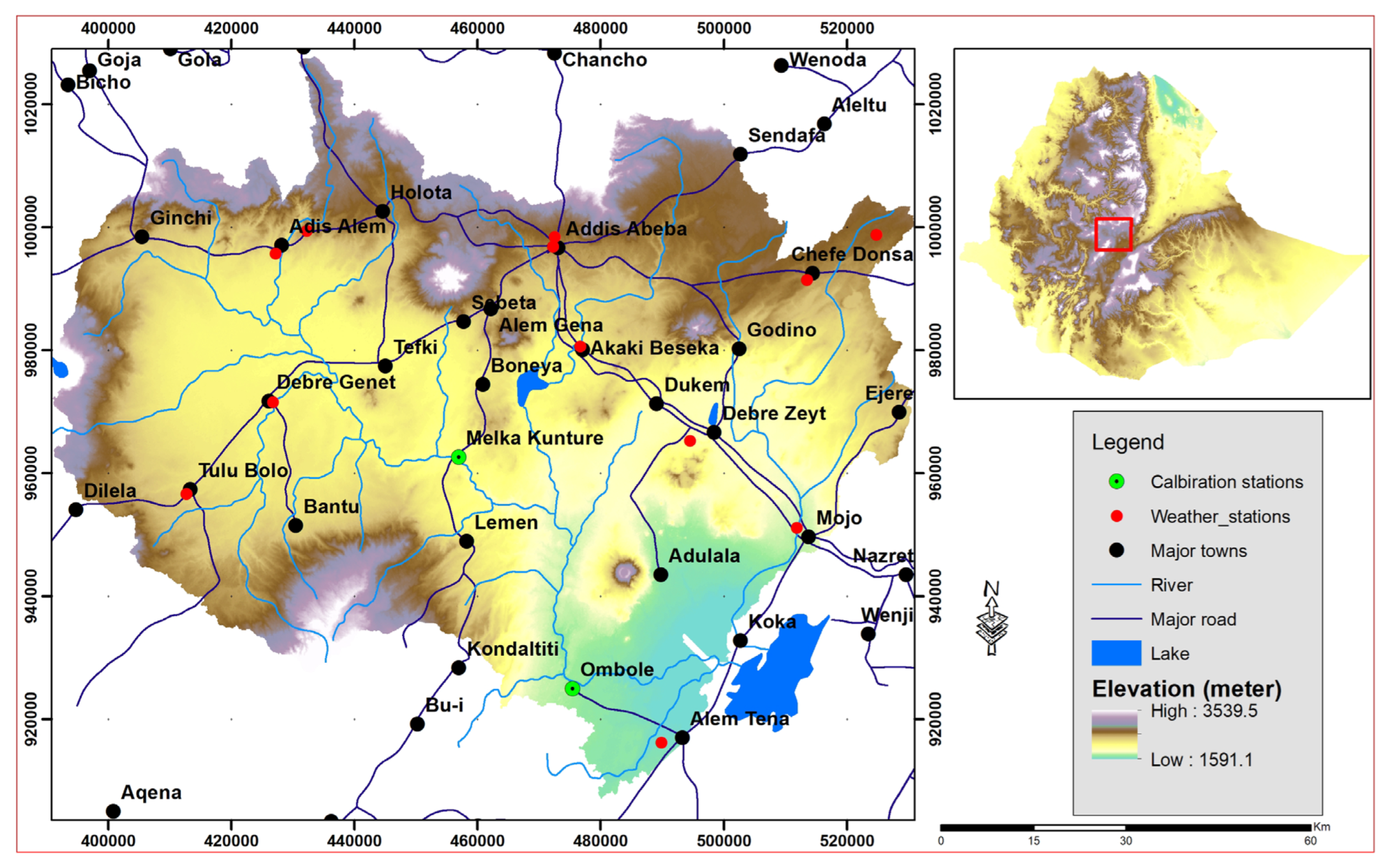



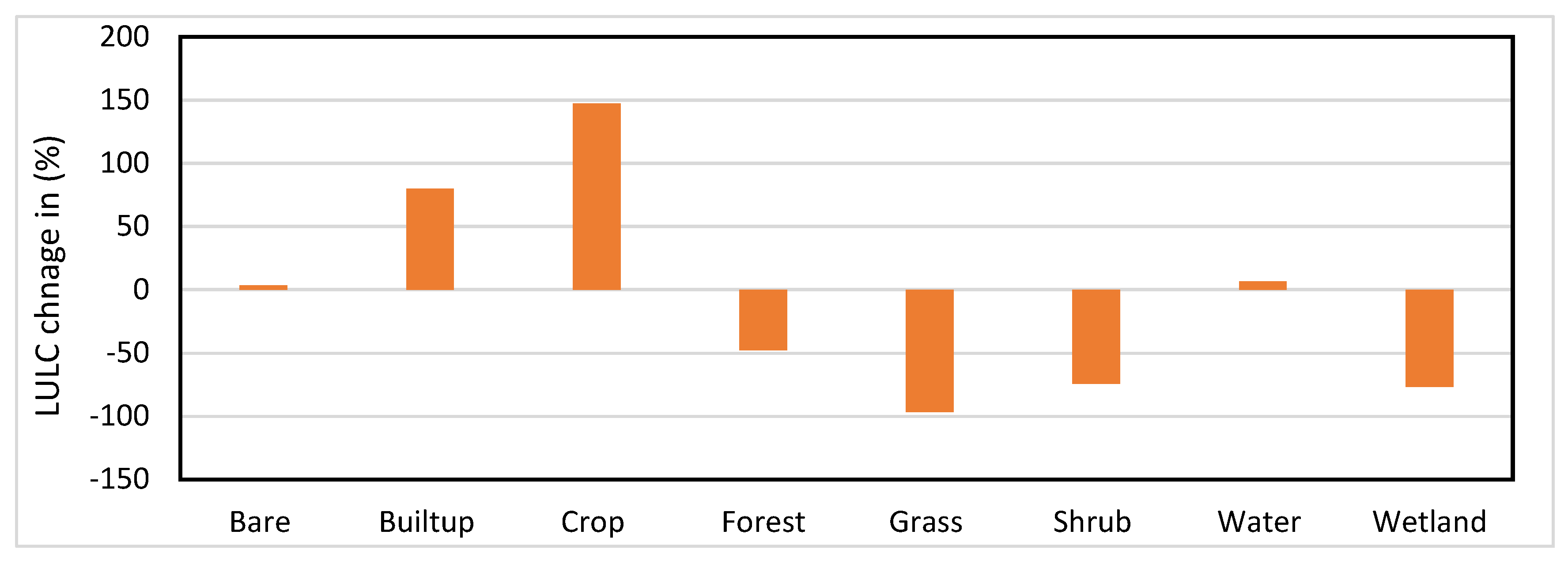
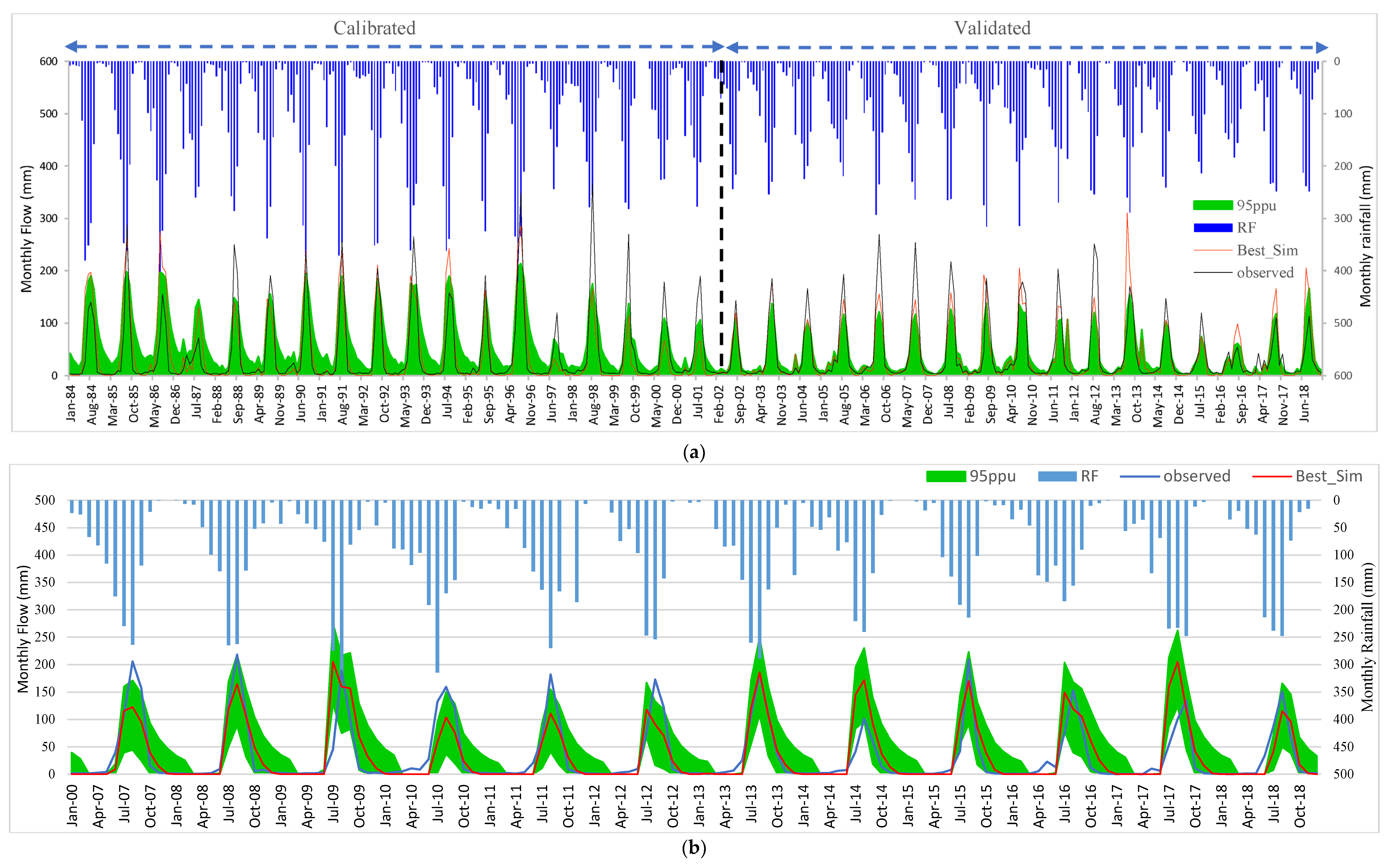



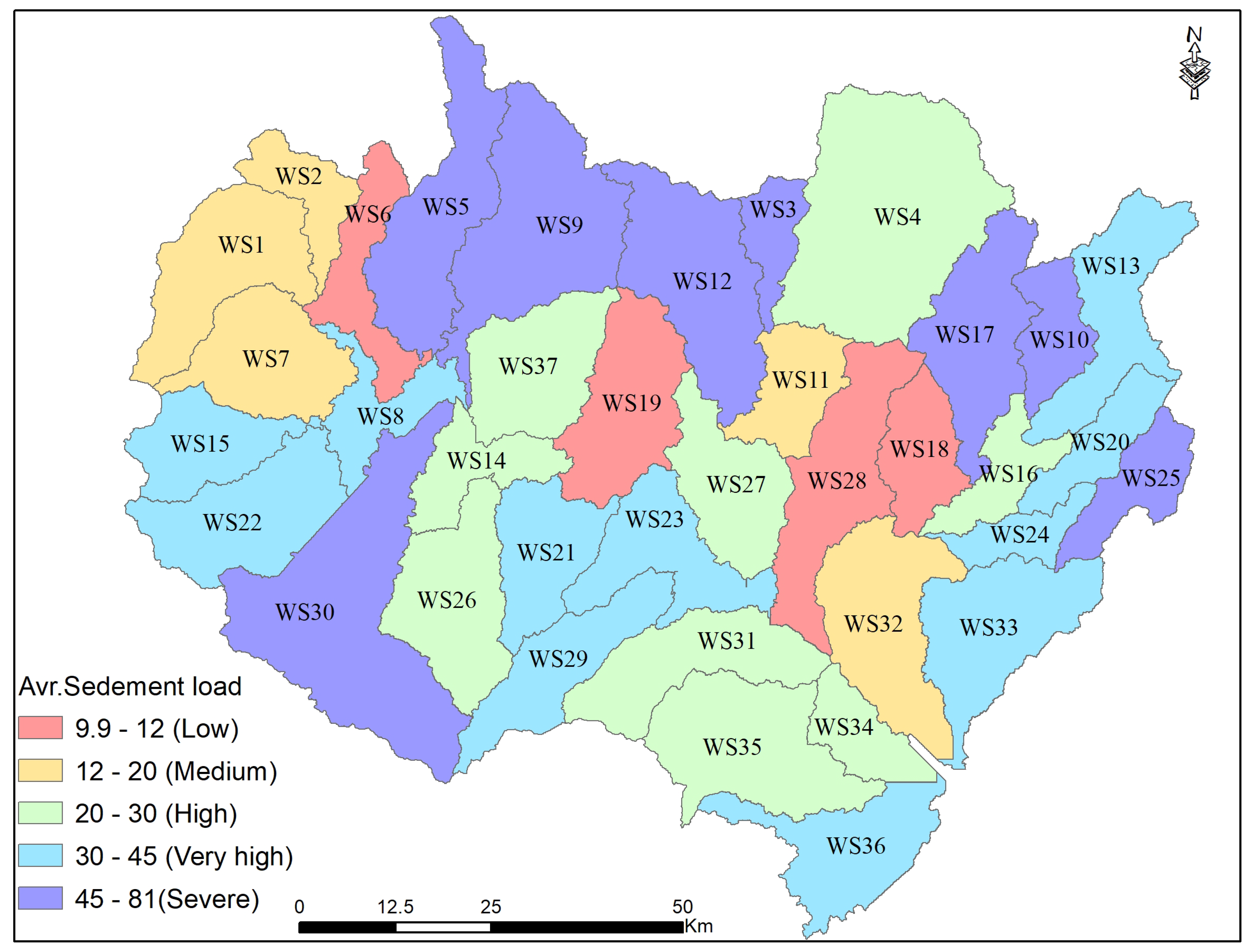
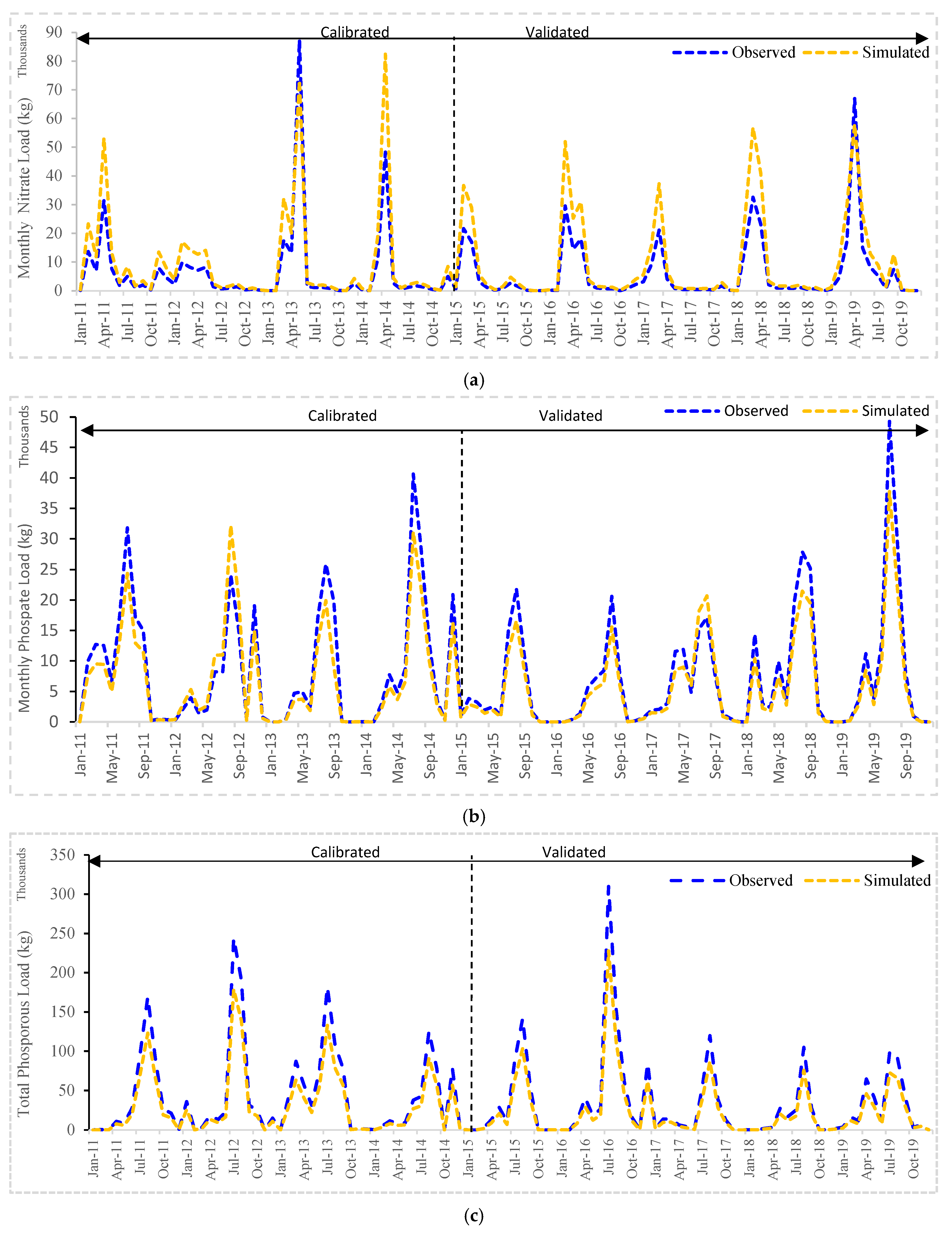
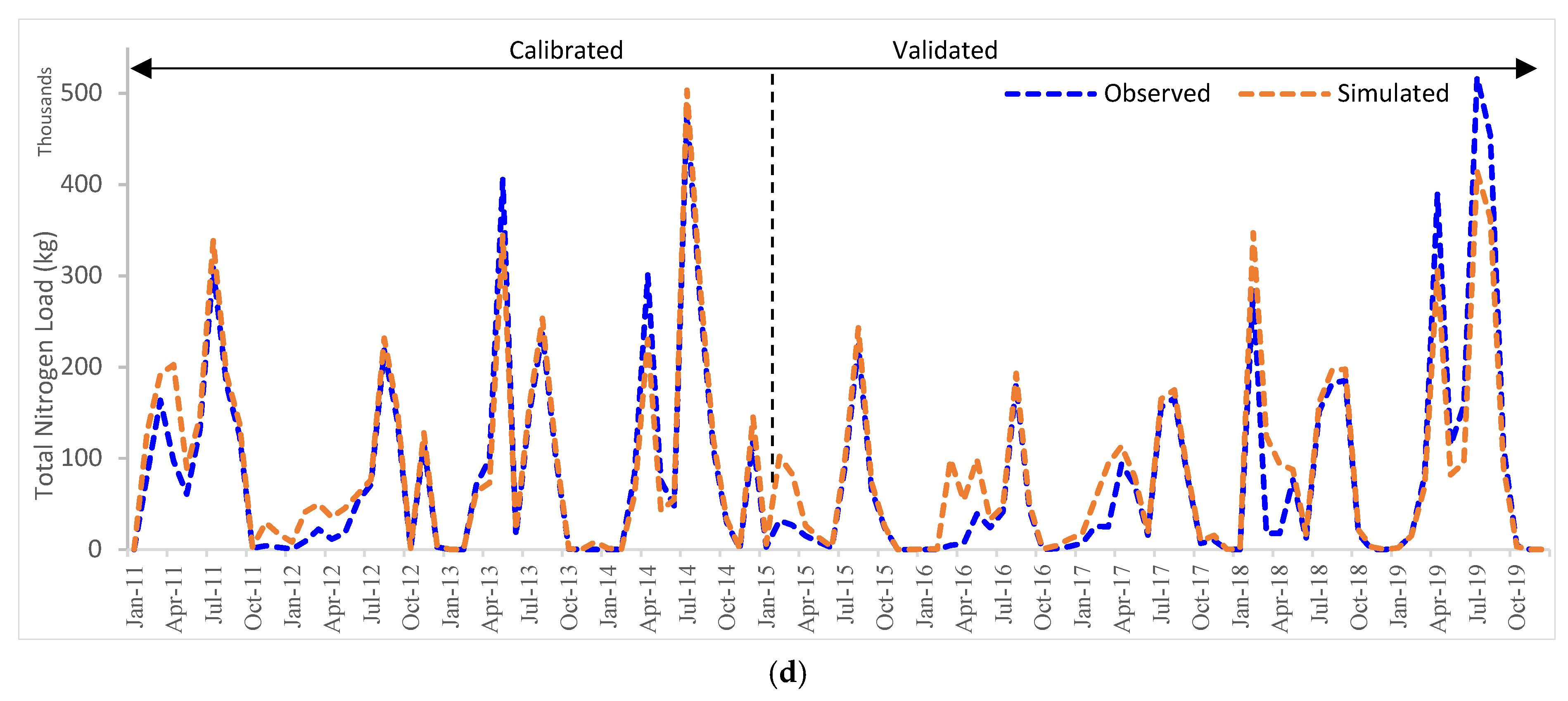


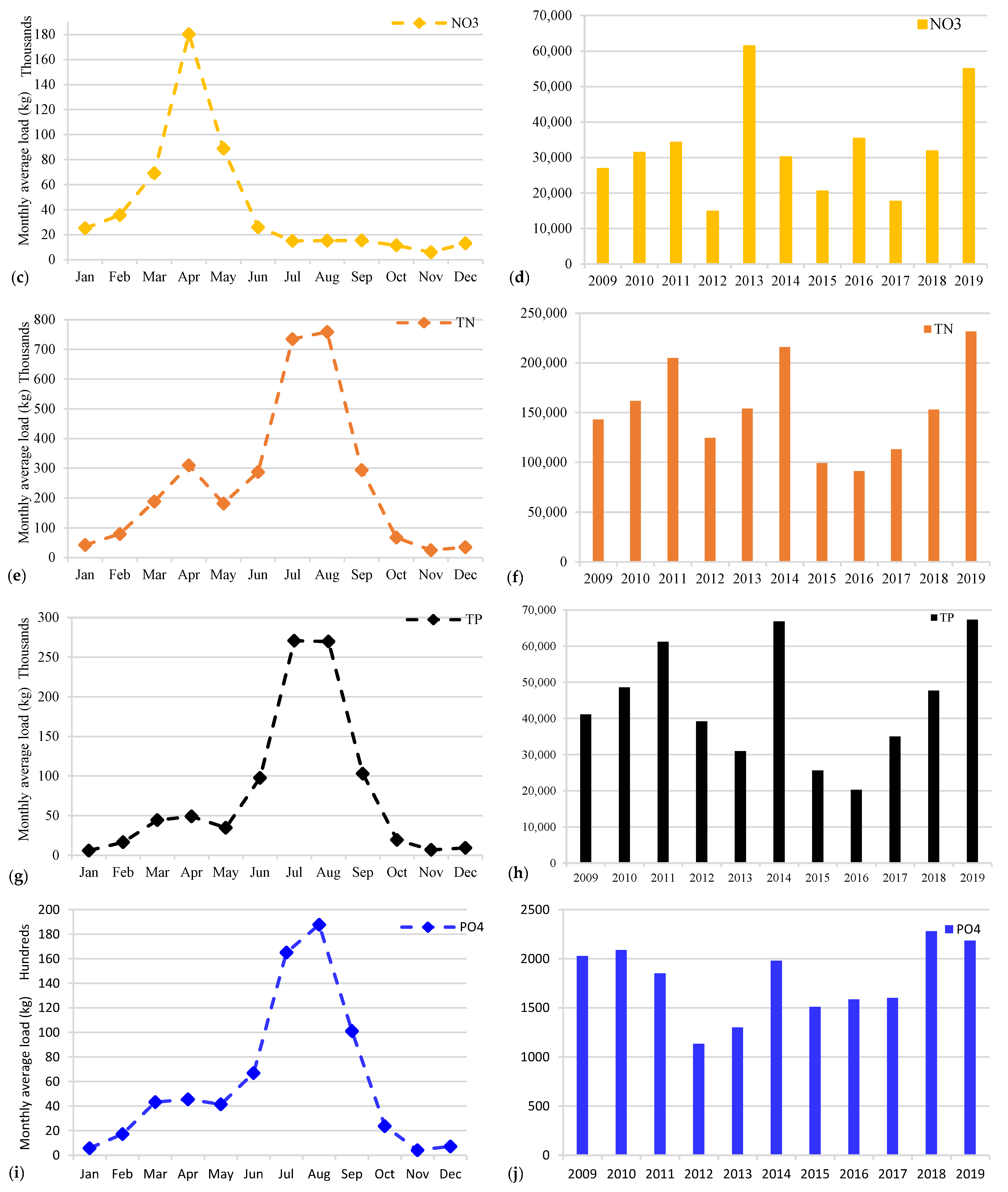

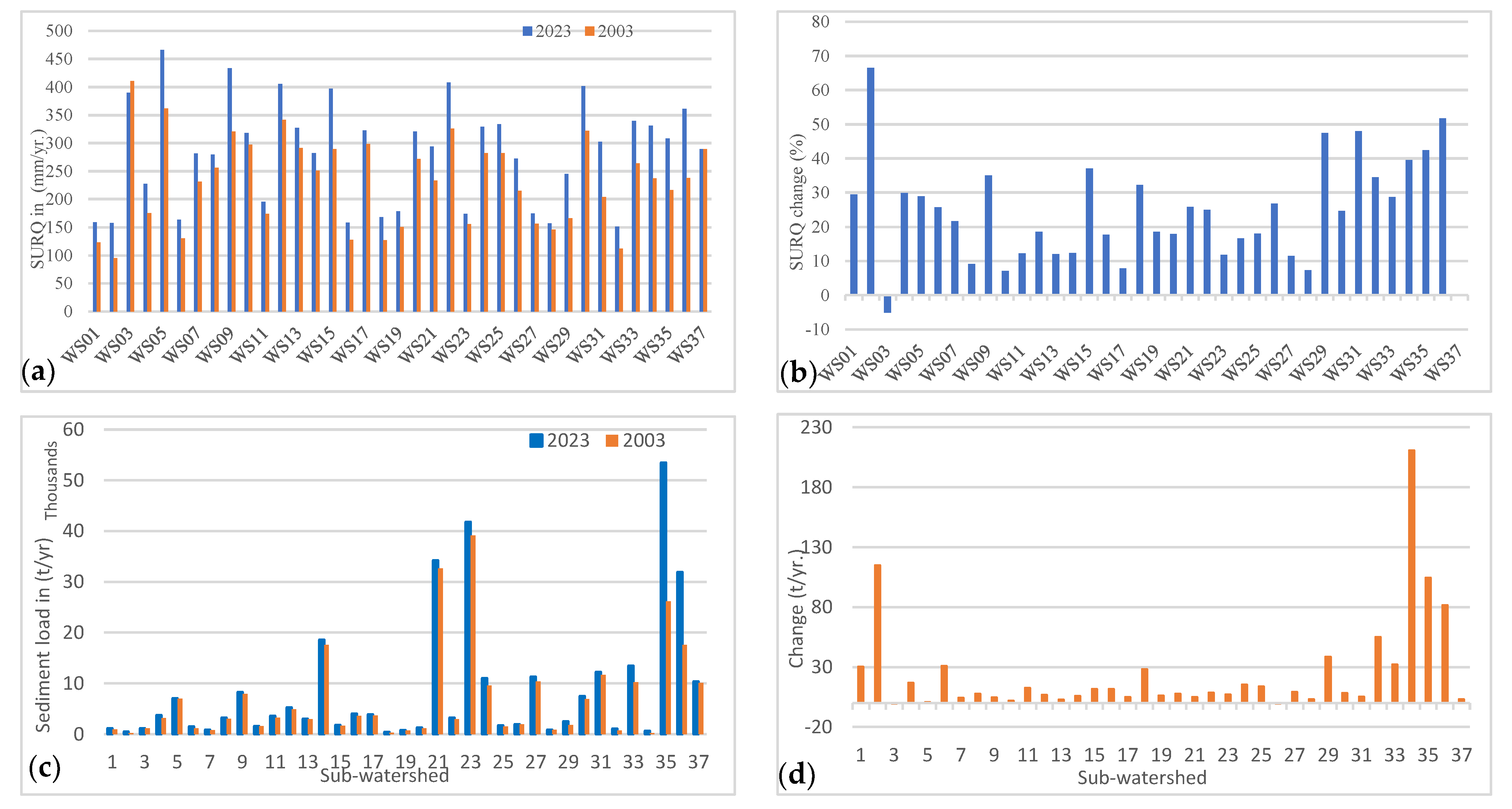


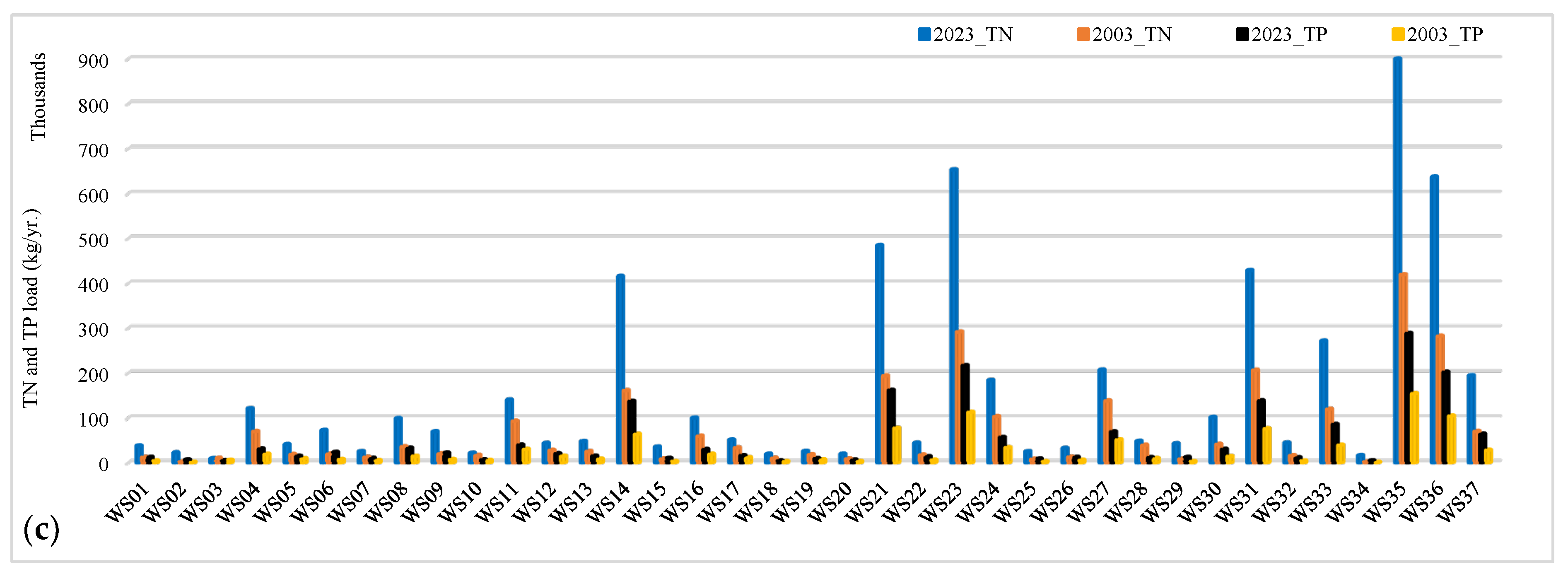
| Data Type | Spatial Resolution/Period | Source |
|---|---|---|
| DEM | 30 m | https://earthexplorer.usgs.gov/, accessed on 31 October 2021 |
| LULC | 10 m (2023), 30 m (2003) | https://earthexplorer.usgs.gov/, accessed on 17 February 2023 https://scihub.copernicus.eu/, accessed on 16 February 2023 |
| Soil map | 1:250,000 | Water and Land Resource Center (WLRC) |
| Rainfall and temperature | 1979–2019 | National Meteorological Agency (NMA) |
| Solar radiation, relative humidity, and wind speed | 1979–2019 | https://climatedataguide.ucar.edu/climate-data accessed on 18 July 2023 |
| Observed stream flow | Daily | Ministry of Water and Energy |
| Observed sediment | Monthly | Ministry of Water and Energy |
| Observed nutrient quality | Monthly (2009–2019) | Ethiopian Construction Design and Supervision; field observation by the researcher |
| Performance Rating | PBIAS | RSR | NSE | ||
|---|---|---|---|---|---|
| Stream Flow | Sediment | N and P | |||
| Very good | PBIAS ≤ ±10 | PBIAS ≤ ±15 | PBIAS ≤ ±25 | 0.00 ≤ RSR ≤ 0.50 | 0.75 < NSE ≤ 1.00 |
| Good | ±10 < PBIAS ≤ ±15 | ±15 < PBIAS ≤ ±30 | ±25 < PBIAS ≤ ±40 | 0.50 < RSR ≤ 0.60 | 0.60 < NSE ≤ 0.75 |
| Satisfactory | ±15 < PBIAS ≤ ±25 | ±30 < PBIAS ≤ ±55 | ±40 < PBIAS ≤ ±70 | 0.60 < RSR ≤ 0.70 | 0.36 < NSE ≤ 0.60 |
| Bad | ≥±25 | PBIAS ≥ ±55 | PBIAS ≥ ±70 | RSR > 0.70 | ≥±0.36 |
| Flow Parameter | Parameter Description | t-Stat | p-Value |
|---|---|---|---|
| V_RCHRG_DP.gw | Deep aquifer percolation fraction | −7.363 | 0.000 |
| V_CH_K2.rte | Effective channel hydraulic conductivity (mm/h) | 6.386 | 0.000 |
| R_CN2.mgt | SCS curve number for moisture condition II | −2.062 | 0.040 |
| V_ALPHA_BF.gw | Base flow alpha factor (days) | 1.203 | 0.230 |
| V_SURLAG.bsn | Surface runoff lag time | −1.120 | 0.263 |
| V_CANMX.hru | Maximum canopy storage | −1.103 | 0.271 |
| R_USLE_K(..).sol | Soil erodibility factor in USLE | −0.955 | 0.340 |
| V_GW_DELAY.gw | Groundwater delay (days) | −0.863 | 0.389 |
| V_REVAPMN.gw | Threshold depth of water in the shallow aquifer (mm) | −0.733 | 0.464 |
| V_GW_REVAP.gw | Groundwater revap coefficient | 0.589 | 0.556 |
| R_OV_N.hru | Overland Manning roughness | −0.529 | 0.597 |
| R_SOL_BD(..).sol | Moist bulk density (Mg/m3 or g/cm3) | −0.469 | 0.639 |
| V_GWQMN.gw | Threshold depth of water in the shallow aquifer (mm) | 0.321 | 0.749 |
| R_SOL_AWC(..).sol | Available water capacity of the soil layer (mm/m) | −0.072 | 0.943 |
| Sediment | |||
| V_CH_D.rte | The average depth of the main channel | 12.411 | 0.000 |
| R_SLSUBBSN.hru | Average slope length (m) | 2.868 | 0.004 |
| A_CH_COV2.rte | Channel cover factor | −2.554 | 0.011 |
| R_HRU_SLP.hru | Average slope steepness (m/m) | −2.072 | 0.039 |
| A_CH_ERODMO(..).rte | Channel erodibility factor | 1.023 | 0.307 |
| V_CH_W2.rte | Average width of channel at the top of the bank (m) | −0.997 | 0.320 |
| V_SPEXP.bsn | Exponent parameter for calculating the channel sediment routing | 0.951 | 0.343 |
| A_USLE_P.mgt | The USLE equation supports the parameter | −0.489 | 0.625 |
| A_USLE_C{..}.plant.dat | Min value of USLE C factor applicable to the land cover/plant | −0.003 | 0.998 |
| R_CH_BED_TC.rte | Critical shear stress of channel bed (N/m2) | −0.001 | 0.999 |
| Nutrient parameter | |||
| R_RS5.swq | The organic P settling rate | 1.822 | 0.069 |
| R_PPERCO.bsn | Phosphorus percolation coefficient (10 m3/Mg) | −1.532 | 0.127 |
| R_P_UPDIS.bsn | Phosphorus uptake distribution parameter | −1.369 | 0.172 |
| R_ERORGP.hru | P enrichment ratio with sediment loading | −1.098 | 0.273 |
| R_GWSOLP.gw | Concentration of soluble phosphorus in groundwater (mg P/L) | 0.888 | 0.375 |
| R_USLE_P.mgt | USLE support practice factor | 0.825 | 0.410 |
| V_PSP.bsn | Phosphorus availability index | −0.410 | 0.682 |
| R_BC4.swq | Rate constant for mineralisation of organic P to dissolved P in the reach at 20 °C (1/day) | 0.115 | 0.908 |
| R_PHOSKD.bsn | Phosphorus soil partitioning coefficient | 0.011 | 0.991 |
| Period | Observatory | p-Factor | r-Factor | PBIAS | RSR | R2 | NS | |
|---|---|---|---|---|---|---|---|---|
| Calibration | 1979–2001 | Hombole | 0.94 | 0.94 | 4.6 | 0.58 | 0.68 | 0.67 |
| Validation | 2002–2018 | 0.92 | 0.8 | 5.4 | 0.57 | 0.68 | 0.67 | |
| Validation | 2002–2018 | Melka Kunture | 0.63 | 0.94 | −4.3 | 0.58 | 0.69 | 0.66 |
| Period | Observatory | p-Factor | r-Factor | PBIAS | RSR | R2 | NSE | |
|---|---|---|---|---|---|---|---|---|
| Calibration | 1979–2001 | Hombole | 0.82 | 0.71 | −14.9 | 0.69 | 0.65 | 0.70 |
| Validation | 2002–2018 | 0.76 | 0.63 | 20.8 | 0.55 | 0.61 | 0.64 | |
| Validation | 2002–2018 | Melka Kunture | 0.74 | 0.94 | 34.3 | 0.58 | 0.64 | 0.58 |
| Soil Load Rate (t/ha/y) | Class Severity | Area (ha) | Area (%) | Average Annual Load (t/Year) | Average Annual Load (%) |
|---|---|---|---|---|---|
| <12 | Low | 33,804.1 | 14.4 | 99,083.2 | 10.0 |
| 12–20 | Moderate | 35,095.6 | 14.9 | 124,434.1 | 12.5 |
| 20–30 | High | 68,171.7 | 28.9 | 258,910.9 | 26.1 |
| 30–45 | Very high | 32,811.2 | 13.9 | 250,431.7 | 25.3 |
| >45 | Severe | 65,666.1 | 27.9 | 258,944.5 | 26.1 |
| Nutrient | Calibration | Validation | ||||
|---|---|---|---|---|---|---|
| PBIAS | RSR | NSE | PBIAS | RSR | NSE | |
| NO3− | 14.2 | 0.53 | 0.66 | 15.6 | 0.49 | 0.52 |
| PO43− | 17.8 | 0.42 | 0.64 | 12.1 | 0.52 | 0.60 |
| TN | 7.8 | 0.54 | 0.61 | 13.9 | 0.57 | 0.65 |
| TP | 12.6 | 0.48 | 0.54 | 9.7 | 0.59 | 0.63 |
Disclaimer/Publisher’s Note: The statements, opinions and data contained in all publications are solely those of the individual author(s) and contributor(s) and not of MDPI and/or the editor(s). MDPI and/or the editor(s) disclaim responsibility for any injury to people or property resulting from any ideas, methods, instructions or products referred to in the content. |
© 2024 by the authors. Licensee MDPI, Basel, Switzerland. This article is an open access article distributed under the terms and conditions of the Creative Commons Attribution (CC BY) license (https://creativecommons.org/licenses/by/4.0/).
Share and Cite
Assegide, E.; Alamirew, T.; O’Donnell, G.; Dessie, B.K.; Walsh, C.L.; Zeleke, G. Assessing Non-Point Source Pollution in a Rapidly Urbanizing Sub-Basin to Support Intervention Planning. Water 2024, 16, 3447. https://doi.org/10.3390/w16233447
Assegide E, Alamirew T, O’Donnell G, Dessie BK, Walsh CL, Zeleke G. Assessing Non-Point Source Pollution in a Rapidly Urbanizing Sub-Basin to Support Intervention Planning. Water. 2024; 16(23):3447. https://doi.org/10.3390/w16233447
Chicago/Turabian StyleAssegide, Endaweke, Tena Alamirew, Greg O’Donnell, Bitew K. Dessie, Claire L. Walsh, and Gete Zeleke. 2024. "Assessing Non-Point Source Pollution in a Rapidly Urbanizing Sub-Basin to Support Intervention Planning" Water 16, no. 23: 3447. https://doi.org/10.3390/w16233447
APA StyleAssegide, E., Alamirew, T., O’Donnell, G., Dessie, B. K., Walsh, C. L., & Zeleke, G. (2024). Assessing Non-Point Source Pollution in a Rapidly Urbanizing Sub-Basin to Support Intervention Planning. Water, 16(23), 3447. https://doi.org/10.3390/w16233447







